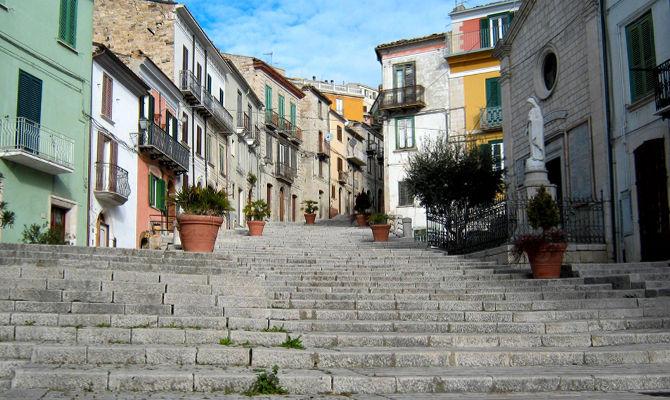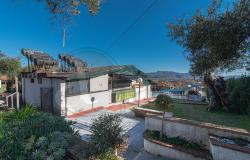Main photo credit: Turismo.it.
The town of Trivento sits on a rocky hill, above the valleys of Molise. It is one of those places where locals pause their conversation for a second or two if a stranger passes by and greet you with a “buongiorno” or “buonasera”. It is the type of place that I love visiting; it sticks to its quirky old ways and has its own character, unchanged by time and progress.
The story of Trivento goes centuries before the foundation of Rome. Local legends say that the town was founded by the mysterious Samnite people, who had a tradition of the Primavera Sacra (Sacred Spring) when animals were sacrificed and firstborns with birthdays between March 1 and June 1 became sacrati, or protected by god Marmete (the Samnite version of Mars). Once grown up, they follow a sacred ox to colonize new lands. One ox stopped to drink from the springs and the town was founded on the hill above. Later the invincible ancient Romans took over, then the Lombards, later the Normans. For centuries, it passed from one formidable lord to another who fought never ending small feudal wars over this land that remained a quiet backwater.
Once I arrived in Trivento, I walked up the wide stairway of San Nicola (Scalinata di San Nicola), which has 365 steps and connects the newer lower part of town with the older one on the top of the hill. Fun for visitors but imagine walking up and down with your shopping bags? Certainly a great cardio workout! No wonder the old ladies of Trivento looked so energetic and smiled at us non-stop!!
I strolled along the cobbled streets admiring old massive wooden doors with ornate doorways and lovely flowerpots with bright blooms. Squeezing through the narrow dark passages between ancient crumbling buildings I imagined clandestine dates and furtive kisses, generations of hard working workers who passed through serving the noble local families and feudal intrigues that interrupted the quiet pace of life of this provincial town a long time ago.
 [A typical street in Trivento]
[A typical street in Trivento]
The pride of the town is the Trivento cathedral, Chiesa dei Santi Nazario, Celso e Vittore built in the 11th century on the spot where a pagan temple dedicated to the goddess Diana once stood. While I was inside gazing at the frescoes and stained glass, a man came in and asked if I wanted to see the crypt. I surely said yes and he waived me to a dark set of steps going to the basement. “Make sure you switch the light off when you leave,” he said in a stern voice without a smile pointing at a worn down printed sign on the wall near the switch that said in Italian “Turn the lights off when leaving”. “Two tourists were here last week. I came in two hours after they left, the light was still on, all that time. They knew how to turn it on but couldn’t bother switching it off,” he mumbled walking away.
The San Casto Crypt discovered by accident only in 1928 was an early Christian church built in the 4th century re-using Roman stones and columns (you can still see some inscriptions dating to the Roman era). The spectacular Byzantine frescoes had not been preserved well but I could still see their beautiful lines and colours. During excavation of the outside walls of the crypt archaeologists found human bones and rumours of human sacrifices spread in the town, however, historians think it is more likely that a small cemetery was located here some time ago. I stood there in silence for a few minutes, touching the cool ancient stones and admiring the curves of the vaulted ceiling.
 [The San Casto Crypt]
[The San Casto Crypt]
Several beautiful churches, crumbling noble palaces and laid-back atmosphere make Trivento a gem of a town to explore. I spent some time sipping a spritz in an unpretentious small bar eavesdropping on a few local men discussing someone who was trying to fix the roof on his shed and the way he was doing it all wrong. I popped into the Pizzeria Bar Jolly for a few slices of thin crispy pizza that I gobbled up at an outdoor table while admiring the stunning views over the town. The green mountains stretched into the horizon, as far as the eye can see, dotted with towns and villages here and there, off the well-trodden tourist routes.
Afterwards, I climbed to the top of the town looking for the Trivento castle built as a defence against barbaric and Saracen invasions. I wanted to see battlement towers, bastions, moats and drawbridges; however, one thousand years and constant change of ownership have not been kind to the castle reduced to a walled plain building albeit still imposing. Near the rusty gate, I spotted a carved coat of arms of the current owners, the Colaneri family. The path behind the gate ran overgrown and unreachable teasing me with secrets of Trivento’s past and present.

